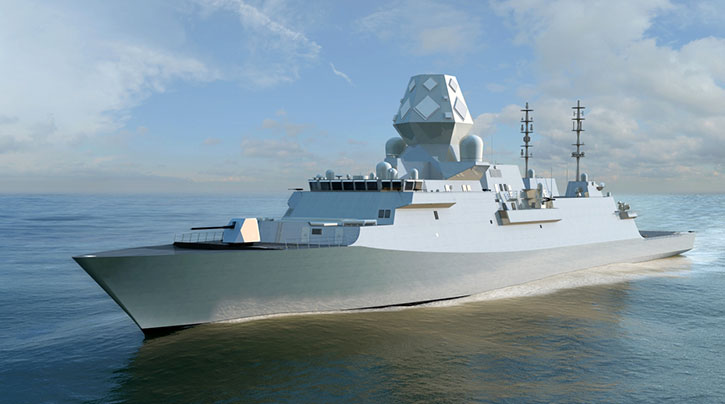The Australian Government selected BAE Systems to build nine new frigates for the Australian Navy under the Australian Navy SEA 5000 Phase 1 Future Frigate project. The new Hunter Class frigates will replace the current ANZAC class frigates and will be optimized for anti-submarine warfare (ASW). The new vessels. The new warships are based on the Global Combat Ship design pioneered by BAE Systems, which was also selected for the Royal Navy Type 26 frigate.
[wlm_nonmember]Subscribe to read the full article
[/wlm_nonmember]
The AU$35 billion program is part of a massive $200 billion continuous shipbuilding program that will deliver 54 new vessels – surface ships and submarines – over the next decade. The frigate program will secure 4,00 Australian jobs across the continent.
By 2030, over half of the world’s submarines will be operating in the Indo-Pacific region where Australia’s interests are most engaged. The primary purpose of the Hunter Class frigates is to detect, track and, if required, destroy enemy submarines. The first Hunter class frigate will be introduced into service from the late 2020s.
A 150 meter long, and 8,800 tons displacement the Hunter class frigates will be operated by a crew of 180 personnel. The Future Frigates will replace the eight ANZAC class frigates currently in service. The ANZAC’s entered service in 1996 and are expected to be maintained until the 2040s, when the youngest ship, HMAS Perth, will have been in service for more than 35 years.
The $35 billion spending is expected to have 65-75 percent local share, with the construction of the ships done in Adelaide, southern Australia. The program also includes infrastructure investment, $130 million at Osborne Naval Shipyard, South Australia, for the land-based test facility and at Henderson, at HMAS Sterling in Western Australia, along with $670 million for the Ship Zero training school for the Hunter class.
In this selection, BAE Systems has beaten its two European competitors, the Italian Fincantieri and Spanish Navantia. Both offered designs based on existing vessels. Although Australia selected a vessel that exists only on paper, the Navy is confident the selection was the right one. “The evaluation was quite stringent and strict against the requirements that we had. By the time that the first of these are built, there will already be four other hulls in the water.” Vice Admiral Barrett Chief of the Australian Navy said. “It has also been designed and is being built by a nation which has, on a regular basis in the North Atlantic and elsewhere, been chasing submarines as a matter of course on a day by day proposition. We’ve evaluated and studied extensively how they intend to do it and we believe – and I spoke as recently as last night to the First Sea Lord, my equivalent in the Royal Navy – and I am assured by his comments, of just how far and how successful this platform will be as the world’s most advanced ASW frigate.” Adm. Barrett added.
The Hunter Class frigates will be built by ASC Shipbuilding at the Osborne Naval Shipyard. ASC Shipbuilding, currently wholly owned by the Commonwealth, will become a subsidiary of BAE Systems during the build.
[wlm_ismember]For the duration of the program, BAE Systems will take control of the Australian government-run ACS Shipbuilding. “BAE will take responsibility for ASC, they will take responsibility for the project because they’re the prime, they’ll build the ships and at the end of the project, the Commonwealth will resume ownership of ASC.” Prime Minister Malcolm Turnbull said. By the conclusion of the frigate build, ASC Shipbuilding will be a strategic national asset capable of independently designing, developing and leading the construction of complex, large naval warships.
“At the end of this project which is decades long, you will then have an Australian shipbuilding company, ASC, which will have built nine of the most advanced warships in the world, with all of the skills and expertise and IP and staff, workers. And that, of course, becomes then the basis, as part of our national shipbuilding, our sovereign industry.” PM Turnbull explained. This does not affect the Offshore Patrol Vessels, Air Warfare Destroyers, or the sustainment of the Collins Class submarines and will not preclude ASC Group from pursuing future shipbuilding opportunities.
“The reason we are doing this is to ensure that BAE Systems is fully responsible and accountable for the delivery of this program, on time and on budget.” Said Minister for Finance Mathias Cormann, “The ASC Group and of course the work in relation to the (currently ongoing) Offshore Patrol Vessels and the Air Warfare Destroyer continues as before. The Collins class submarine maintenance activities continue as per before.
According to Cormann, while it moves under BAE Systems, ASC Shipbuilding, will be transferred to become a subsidiary to BAE Systems, just for the period of the build. ”The ASC Group is not precluded from pursuing future shipbuilding opportunities as well,” Cormann said.
“Our first priority is always capability. But for the first time the Turnbull Government has made its second priority ensuring that out of this enormous spend,” said Christopher Payne, Minister for Defence Industry. “This heft of $200 billion, we do the most we can to establish a sophisticated, advanced manufacturing industry in this country. For the first time will have a shipbuilding and submarine building capability that will last 100 years.
[/wlm_ismember]The $35 billion spending is expected to have 65-75 percent local share, with the construction of the ships done in Adelaide, southern Australia. The program also includes infrastructure investment, $130 million at Osborne Naval Shipyard, South Australia, for the land-based test facility and at Henderson, at HMAS Sterling in Western Australia, along with $670 million for the Ship Zero training school for the Hunter class.




















